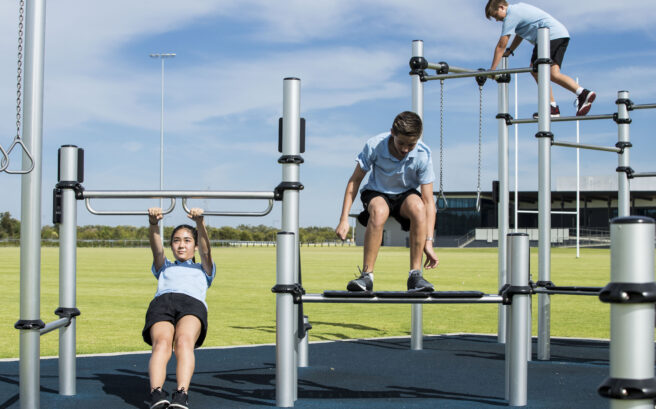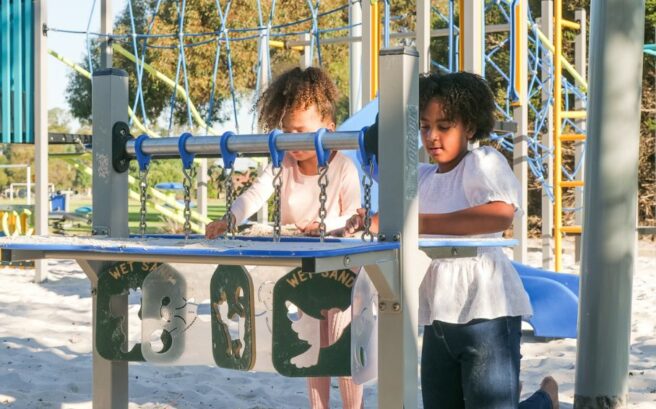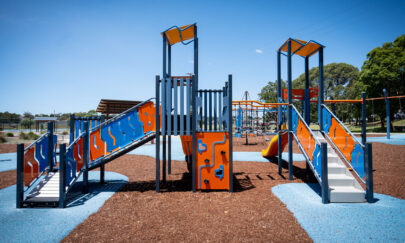Playground activities & benefits explained

Learn how types of play and their role in playgrounds contributes to holistic development.
Playgrounds are more than just spaces for children to have fun; they are dynamic environments that foster physical, social, emotional and cognitive development. As professional playground designers, it’s our job to understand the importance of offering a diverse range of activities that cater to the varying needs and interests of children. So what are the different types of play? And what product attributes should you be looking for?
While there are countless different names and definitions, let’s start by looking at the 6 key types of play we consider when designing a playground.

1. Active play
Active play encompasses a wide range of physical activities that engage children’s bodies and promote physical fitness. Traditional playground equipment such as swings, slides, climbing structures and monkey bars encourage children to run, jump, climb and balance, improving their gross motor skills, coordination and overall physical health. Research shows that regular participation in active play reduces the risk of obesity, enhances cardiovascular health and contributes to the development of strong bones and muscles.
2. Imaginative play
Imaginative play, also known as pretend or dramatic play, allows children to explore their creativity, express themselves and make sense of the world around them. Playhouses, themed play structure, and imaginative play panels provide opportunities for children to engage in role playing, storytelling and make-believe scenarios. Imaginative play promotes language development, problem-solving skills, empathy and emotional regulation. By assuming different roles and perspectives, children learn to collaborate, negotiate, and communicate effectively with their peers.

3. Sensory play
Sensory play engages children’s senses, including touch, sight, smell and hearing, providing rich and stimulating experiences that support brain development and sensory integration. Sand and water play tables, musical play equipment and textured surfaces invite children to explore different sensations and stimuli. Sensory play promotes cognitive skills such as observation, experimentation and cause-and-effect reasoning. It also supports emotional regulation, reduces stress and anxiety and enhances concentration and attention span.
4. Social play
Social play involves interaction and collaboration with peers, fostering the development of social skills, cooperation, empathy and friendship. Multi-user swings, seesaws, group slides, and cooperative games promote shared experiences and teamwork. Social play helps children learn to navigate social dynamics, resolve conflicts and develop positive relationships with others. It also builds a sense of belonging and community, fostering a supportive and inclusive environment where every child feels valued and included.

5. Creative play
Creative play encourages self-expression, exploration and experimentation, allowing children to unleash their imagination and artistic talents. Art panels, musical equipment, chalkboards, sand play and open-ended play materials stimulate creativity and innovation. Creative play promotes self-confidence, problem-solving skills and divergent thinking. Through creative play, children develop a sense of agency and autonomy, shaping their identities and aspirations.
6. Cognitive play
Cognitive play involves activities that challenge children’s thinking, problem-solving and decision-making skills. Puzzle panels, maze walls, educational games and interactive learning stations provide opportunities for cognitive engagement and intellectual stimulation. Cognitive play enhances critical thinking, spatial awareness, mathematical reasoning and literacy skills. It encourages children to explore, experiment and discover new ideas and concepts in a playful and hands-on manner.
Designing a playground isn’t about choosing colours and themed graphics (although these are important considerations!). We place great emphasis on considering the types of play listed above, in order to design a playground that creates an effective flow and engages children in a variety of activities that promote holistic development and well-being.
When you’re looking at ForPark products, you may notice various icons are used to indicate product attributes (also known as play activities, values, attributes or functions). Here’s a quick list of the icons we use and their various meanings.
Accessible: Activities designed to accommodate children of all abilities, eliminating barriers and equal access to play opportunities.
Agility: Equipment that promotes speed, flexibility and quick reflexes, enhancing physical fitness and coordination.
Balance: Activities that challenge children’s ability to maintain equilibrium, improving core strength and stability.
Climb: Ascending structures or obstacles that develop upper body strength and spatial awareness.
Coordination: Activities that require precise movements and control, refining fine motor skills and hand-eye coordination.
Imagination: Activities that encourage creative thinking, storytelling and make-believe scenarios, fostering imaginative exploration and self-expression.
Inclusive: Equipment that helps create play environments that welcome and engage children of diverse backgrounds, developmental levels and sensory preferences.
Rocking: Elements that stimulate rhythmic movement or rocking motions, providing sensory stimulation and calming effects.
Role play: Equipment that allows children to assume different roles and personas, promoting social skills, empathy and perspective-taking.
Sensory: Activities that engage the senses, including touch, sight, smell and hearing, supporting cognitive development and sensory integration.
Slide: Equipment that involves descending a sloped surface, providing thrills and developing spatial awareness and risk assessment skills.
Social: Activities that promote interaction, cooperation and communication among peers, building social skills and fostering a sense of community.
Sound: Activities that involve producing or exploring different sounds, enhancing auditory perception and creativity.
Spin: Activities that induce rotational movement, stimulating the vestibular system and promoting balance and coordination.
Strength: Activities that require exertion of physical force, developing muscle strength and endurance.
Designing playgrounds goes beyond aesthetics; it’s about creating environments that inspire and enrich children’s lives. By understanding the diverse types of play and their benefits, we can create playgrounds that cater to children’s varying needs and interests.
Speak to the professionals in play



























